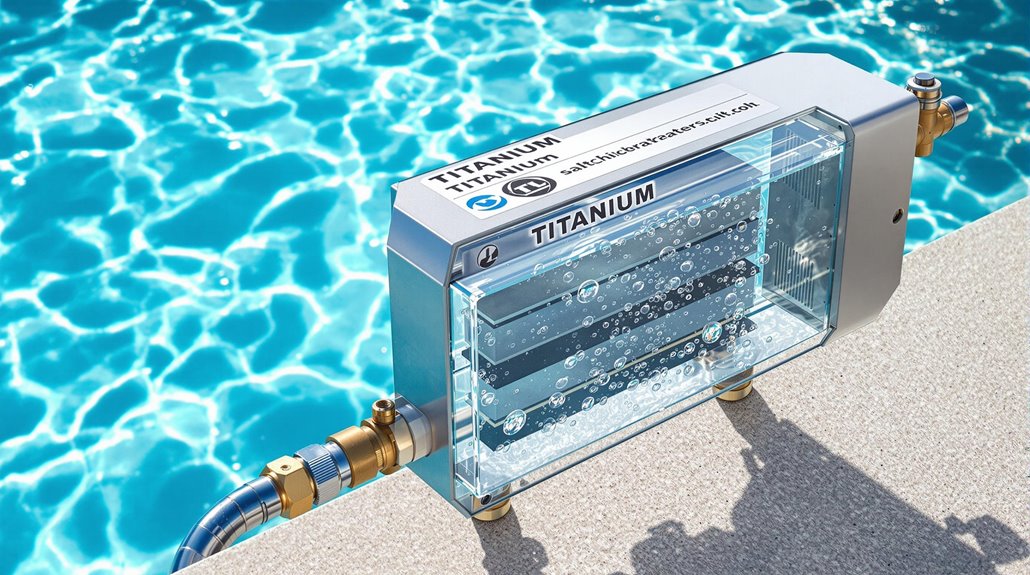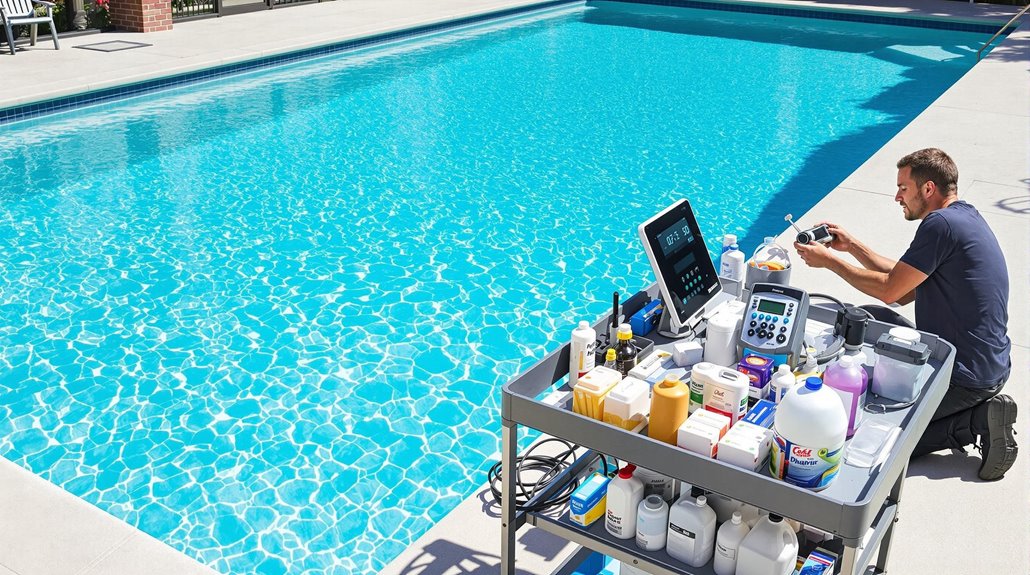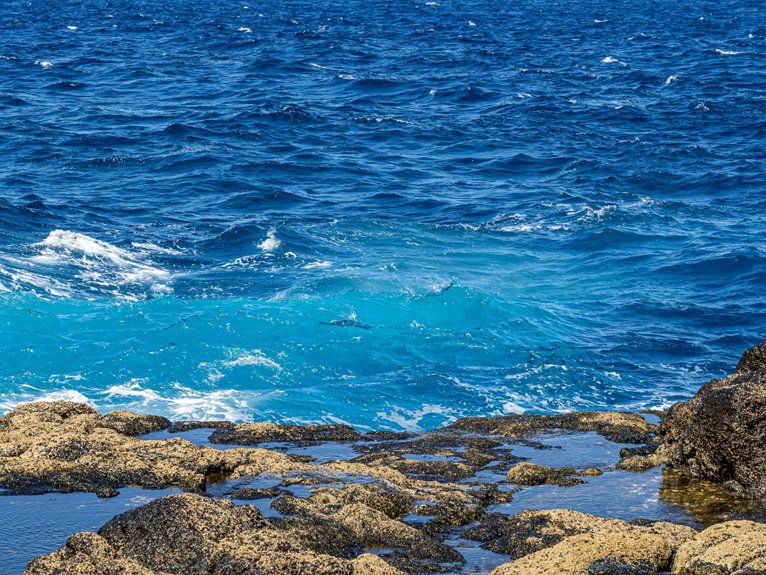While saltwater pools promise gentler swimming conditions and fewer chemicals, you’ll face significant trade-offs. The $2,000-3,500 higher installation costs, plus $600-900 salt cell replacements every 3-6 years, offset the $200-700 annual chemical savings. You’ll still need regular maintenance, and salt’s corrosive nature accelerates equipment wear by 20-30%. The comfort benefits are real, but the financial and maintenance realities deserve your careful scrutiny before making this investment.
How Saltwater Pool Systems Actually Work

While many believe saltwater pools are filled with ocean water, they actually operate through a sophisticated electrochemical process called electrolysis. The system converts regular table salt into chlorine through a salt cell, which houses metal plates that conduct electricity. When saltwater passes through these plates, the electrolysis process splits the salt molecules, creating natural chlorine sanitizer.
You’ll find that maintaining proper water chemistry is surprisingly straightforward. The system automatically generates chlorine as needed, eliminating the need to handle harsh chemicals. A control panel monitors salt levels, typically maintaining them between 2700-3400 parts per million – far lower than ocean water’s 35,000 ppm.
The result? Crystal-clear water that’s gentler on your skin, eyes, and swimwear, without the overwhelming chlorine smell of traditional pools.
The Real Cost Comparison: Saltwater vs. Traditional Pools
While you’ll face considerably higher upfront costs of $1,000-2,500 for a saltwater chlorination system compared to traditional pool setups, the long-term savings paint a different financial picture.
You’re looking at roughly $70-100 annually for salt and cell maintenance versus $300-800 yearly for traditional chlorine tablets and chemicals.
When you examine maintenance costs over a ten-year period, factoring in the occasional $500-800 cell replacement every 3-5 years, saltwater systems typically return your investment through reduced chemical expenses and lower maintenance labor requirements.
Initial Installation Expenses
The initial cost difference between saltwater and traditional chlorine pools can shock unprepared homeowners. A standard chlorinator system runs $300-500, while saltwater generators start at $1,000 and can exceed $2,500 for premium models.
You’ll need to factor in professional installation, which adds another $400-800 to your budget considerations.
The initial setup costs don’t stop there. You’ll require specialized plumbing configurations, salt-resistant equipment, and specific electrical modifications.
These “hidden” expenses typically push your total investment $2,000-3,500 above traditional pool installation costs. Many contractors won’t even mention these requirements until you’re halfway through the project.
Despite what glossy brochures suggest, converting your existing pool isn’t as simple as dropping in a salt cell and calling it a day.
Long-Term Maintenance Breakdown
Despite industry claims about saltwater pools being more economical over time, a detailed cost analysis reveals a different story.
The long term costs of maintaining a saltwater system often exceed traditional chlorine pool expenses when you factor in specialized equipment repairs and replacements.
- Salt cells require replacement every 3-6 years at $600-900 per unit
- Control boards frequently malfunction, costing $500-1,200 to replace
- Higher electricity consumption adds $40-60 to monthly utilities
- Maintenance frequency remains similar to traditional pools
You’ll still need to monitor pH levels weekly, brush walls regularly, and maintain proper water chemistry.
The promised reduction in maintenance time simply doesn’t materialize for most owners.
When factoring in specialized repairs and replacement parts, your five-year operating costs could surpass traditional pool maintenance by 15-25%.
Health and Comfort Benefits for Swimmers
Swimming in saltwater pools offers distinct advantages for your skin, respiratory system, and overall comfort that chlorine-based systems can’t match.
You’ll notice immediate health benefits like reduced eye irritation, less dry skin, and minimal chlorine smell. Your hair won’t turn green, and you won’t need to shower immediately to remove harsh chemicals.
The swimmer comfort in saltwater systems stems from lower chloramine levels – those irritating chemical compounds that cause red eyes and breathing difficulties.
You’re swimming in water that’s roughly one-tenth as salty as ocean water, creating natural buoyancy without the intense salinity.
Studies show that people with asthma and sensitive skin report 65% fewer respiratory issues and skin reactions when switching to saltwater pools.
The gentle sanitizing process means you’re not absorbing harsh chemicals through your skin during your swim sessions.
Common Misconceptions About Saltwater Pools
Contrary to widespread marketing claims, saltwater pools still require chlorine – they simply generate it through electrolysis rather than manual addition.
You’ll find that installation costs for saltwater systems typically run $1,000-2,000 higher than traditional chlorine setups, not lower as some retailers suggest.
While these systems do offer certain advantages, the notion that they’re maintenance-free is misleading since you’ll still need to monitor salt levels, clean cells, and perform regular upkeep to maintain proper chemical balance.
No Chlorine Required Myth
One of the biggest misconceptions about saltwater pools is that they’re completely chlorine-free systems.
In reality, saltwater pools rely heavily on chlorine – it’s just produced differently through a salt cell rather than manual addition. Your pool’s salt chlorinator converts dissolved salt into the same sanitizing chlorine that traditional pools use.
- Salt cells electrolyze sodium chloride (NaCl) into hypochlorous acid, the active sanitizing agent
- The chlorine levels in saltwater pools typically range from 1-3 ppm, similar to traditional pools
- You’ll still need to monitor and maintain proper chlorine levels for safe swimming
- Claims about chlorine alternatives in saltwater systems are often marketing deceptions
Understanding this fundamental truth helps you make an informed decision about pool systems while avoiding unrealistic expectations about maintenance requirements.
The difference isn’t the absence of chlorine – it’s the delivery method.
Installation Costs Are Lower
Many prospective pool owners fall prey to the misleading claim that saltwater systems cost less to install than traditional chlorine setups.
In reality, the installation process for saltwater systems typically runs $1,500 to $2,500 more than conventional chlorine pools. The salt chlorine generator alone costs between $400 and $1,800.
Your initial budget considerations must account for additional components that aren’t required with traditional setups.
You’ll need specialized plumbing configurations, corrosion-resistant equipment, and professional installation by technicians familiar with saltwater systems. The control panel and salt cell installation require precise calibration and positioning.
What’s more, many contractors charge premium rates for saltwater installations due to the specialized knowledge required and increased liability risks.
The promise of lower installation costs is simply marketing spin designed to obscure the true upfront investment.
Maintenance-Free Pool System
The enticing promise of a maintenance-free saltwater pool system represents one of the industry’s most deceptive marketing claims.
While automated cleaning features exist, you’ll still need to monitor and adjust your water chemistry regularly.
- Testing salt and pH levels weekly
- Inspecting and cleaning salt cells every 3 months
- Balancing chlorine levels despite the generator
- Maintaining proper water circulation and filtration
Don’t fall for marketing hype that suggests you can “set it and forget it.”
Your saltwater pool requires consistent attention to maintain safe, swimmable conditions. The system simply converts salt into chlorine automatically – it doesn’t eliminate the need for regular maintenance.
You’ll still spend time checking chemical levels, cleaning the pool, and ensuring proper equipment function. The only real difference? You’re handling salt instead of chlorine tablets.
Maintenance Requirements and Time Investment

Despite widespread claims about saltwater pools being “maintenance-free,” you’ll still need to invest regular time and effort to keep your system running efficiently. Weekly maintenance tasks include checking chemical levels, cleaning the cell, and monitoring salt concentrations. You’re not escaping the fundamentals of pool care.
| Task | Traditional Pool | Saltwater Pool |
|---|---|---|
| pH Testing | 2-3x weekly | 1-2x weekly |
| Chlorine Check | Daily | Weekly |
| Cell Cleaning | N/A | Monthly |
| Salt Testing | N/A | Bi-weekly |
| Deep Clean | Monthly | Monthly |
While the cleaning frequency might be reduced compared to traditional pools, you’ll still need to maintain proper chemical levels and perform regular system checks. The salt cell requires periodic inspection and cleaning to prevent calcium buildup, which can reduce efficiency and increase operating costs.
Impact on Pool Equipment and Surfaces
Salt’s corrosive nature poses significant risks to your pool’s equipment and structural components, creating a complex relationship between convenience and longevity.
Even with proper maintenance, you’ll notice accelerated wear on critical elements, particularly those without adequate corrosion resistance.
- Metal railings and ladder equipment can deteriorate 20-30% faster
- Heaters and lighting fixtures often require replacement within 3-5 years
- Stone coping and decorative features show premature aging and discoloration
- Underwater lighting systems face increased risk of seal failure
Your equipment lifespan directly correlates to material quality and protective measures.
Standard pool equipment wasn’t designed for saltwater systems, forcing you to invest in specialized components.
While manufacturers now offer salt-resistant options, they come at a premium price point.
The harsh reality is that saltwater’s impact on your pool’s infrastructure requires strategic planning and increased capital allocation.
Environmental Considerations and Energy Usage
While saltwater pools might seem eco-friendly at first glance, their environmental footprint raises serious concerns. The chlorine generator’s continuous operation demands significant electricity, often consuming 500 watts more per day than traditional pools.
You’ll find these systems running 8-12 hours daily, dramatically impacting your home’s energy usage.
The salt itself presents another sustainability challenge. You’re adding roughly 500 pounds of salt initially, with regular top-offs needed throughout the season.
When you backwash your pool, that salt-laden water enters the watershed, affecting local ecosystems. Despite industry claims about energy efficiency, studies show that saltwater systems often underperform in sustainability practices.
The irony? You’re paying premium prices for a system that’s marketed as environmentally conscious while potentially causing more ecological harm than traditional chlorine pools.
Conclusion
Don’t let the grass look greener on the saltwater side without doing your homework first. While these systems offer compelling benefits like softer water and reduced chemical handling, they’re not the perfect solution for every pool owner. You’ll need to weigh the higher upfront costs, potential equipment wear, and specialized maintenance requirements against the long-term advantages. Make your decision based on facts, not trends, to guarantee your investment aligns with your specific needs and budget.





